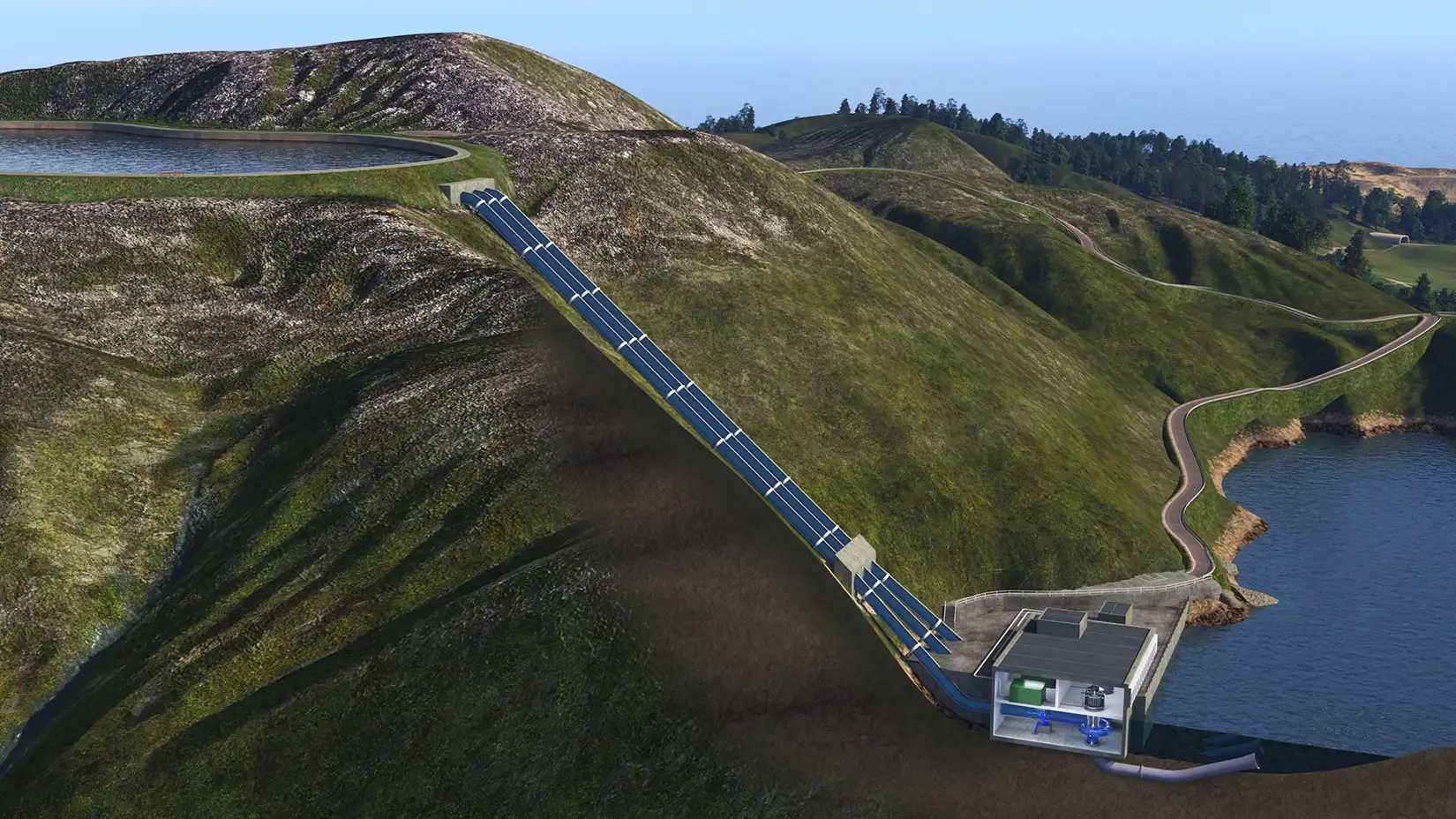Pumped Storage Hydropower
NLR experts are developing tools and partnering with industry to unlock the full potential of pumped storage hydropower (PSH)—a form of hydropower used to generate electricity, store energy, and provide grid services.

Image from IKM 3D.
Pumped storage hydropower facilities rely on two reservoirs at different elevations to store and generate energy. When other power plants generate more electricity than the grid needs, a PSH plant can use that power to pump water into the upper reservoir. Then, when the grid needs more electricity, the PSH plant releases water from the upper reservoir so that it flows down to the lower reservoir, spinning turbines along the way to generate energy.
These facilities play a key role in supporting grid reliability and resilience by providing essential services such as frequency regulation, voltage stabilization, and black start capabilities.
Capabilities
Pumped Storage Hydropower's Role in a Future Power System
According to the U.S. Department of Energy, PSH facilities account for about 96% of the country's utility-scale energy storage. The United States has enough PSH potential to increase its PSH capacity many times over. That added storage could be key to helping the nation build a more reliable, affordable, and secure energy future.
Closing Knowledge Gaps With Innovative Tools and Data
To fully unlock the potential of PSH, additional research and development is essential. Developers, policymakers, grid planners, and other stakeholders need to understand the technology’s costs, benefits, and opportunities. NLR researchers are developing open-source tools to bridge these critical knowledge gaps.
NLR researchers created a national dataset of PSH resources and costs, along with an interactive map to explore the data. Built on geospatial data, the map includes a plant’s anticipated storage duration, capacity, total cost, and more. It can help stakeholders across the hydropower industry and energy sectors identify the potential quantity, quality, and cost of resources needed to construct a new PSH plant.
NLR experts developed a publicly available tool that estimates the cost of new PSH projects based on factors such as site geography, terrain, construction materials used, and more. Researchers and developers can use this tool to calculate the potential cost and performance of new PSH plants.
NLR developed an interactive tool that enables users to evaluate the life cycle greenhouse gas emissions associated with building and operating new PSH facilities. Users can input PSH design specifications at varying levels of detail, including reservoir volume, dam material and dimensions, number and capacity of turbines, and the length of the transmission line connecting the PSH system to the grid. They can compare different PSH scenarios side by side and view emissions by component, material, and life cycle phase.
Partnerships
Through strategic partnerships with industry, utility operators, and hydropower developers, NLR leverages its expertise and cutting-edge capabilities—including the Advanced Research on Integrated Energy Systems (ARIES) platform—to conduct advanced financial, grid, and resource modeling. State-of-the-art research tools help stakeholders identify opportunities and bridge gaps when planning PSH investments.
In partnership with the Hawaii State Energy Office, Argonne National Laboratory, and Pacific Northwest National Laboratory, NLR is addressing the lack of detailed assessment, valuation, and characterization of PSH opportunities in Hawaii. Leveraging previous experience modeling hydropower systems in Hawaii, the research team will use NLR’s PSH Supply Curves Tool to assess the value-added potential of PSH systems at four sites on publicly owned land across the islands of Oahu, Maui, Molokai, and Hawaii.
In partnership with the Tennessee Valley Authority, Argonne National Laboratory, and Pacific Northwest National Laboratory, NLR is addressing the asset valuation challenges that make it difficult for utilities to justify new PSH systems. The labs are reviewing Tennessee Valley Authority’s modeling and valuation approaches while conducting parallel modeling and analysis to provide a broader perspective on PSH valuation. This work utilizes integrated tools for PSH valuation, financial modeling, grid capacity expansion, production cost modeling, resource adequacy assessment, stability modeling, and water modeling for river systems and hydropower resources.
Contact
Share
Last Updated Dec. 6, 2025
